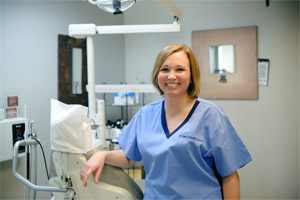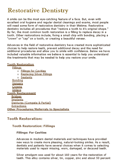In our practice we recommend regular checkups for all individuals over the age of four. The time between office visits can range from every 3 months for those needing close monitoring, to once every 6 months -- the standard recall interval for most patients. These regular visits include a thorough cleaning by a dental hygienist and an oral exam by the doctor. During the oral exam the health of your mouth, including your teeth, gums, cheeks, throat and tongue, are examined. It is also our standard practice to check older fillings and restorations to ensure pressure from chewing, grinding, or clenching has not caused them to wear away, chip or crack. Patients who maintain a standard routine of cleanings and checkups ensure potential dental problems will be detected and treated by a dental professional as early as possible.
Good oral hygiene and maintaining a regular schedule of dental checkups prevents tooth decay, or cavities, in most patients. However, cavities are very common and can develop on any of the surfaces of any tooth. Because they grow, cavities are much easier and less expensive to treat when they are small. A decaying tooth may not hurt, so you may have a cavity and not realize it. At your regular check-ups we will check for tooth decay and periodically use x-rays to check for cavities between teeth. If one is detected, we will treat it by removing the decay and placing a filling (restoration) in the tooth. More information on fillings can be found in the Restorative Dentistry section on this website.
Patients with older dental work may have silver fillings. Our practice recommends the replacement of silver fillings with white (composite resin) fillings as a treatment to prevent further tooth decay. Below is a summary of the general reasons for this recommendation:
- Silver fillings are not bonded to the tooth. As a result, even with expert placement, a micro-gap remains between the tooth surface and the filling. Over time, this micro-gap can harbor food, plaque and bacteria that are unable to be removed with brushing and flossing causing further tooth decay.
- Leading clinicians in the dental field all support research demonstrating that expansion and inherent weakness of aging amalgams (silver fillings) cause teeth to fracture and therefore need more extensive treatment in the future.
- Research also shows that upon removal, many teeth formerly holding amalgam fillings contain fracture lines in the pulpal floor caused by the unsupportive nature of amalgam restorations and recurrent decay under the restoration not visible on x-ray. Replacing the existing silver filling with another amalgam can result in possible fracture of the tooth, pain, endodontic and/or crown procedures.
- If a tooth containing an amalgam filling were to break the most likely treatment would be crowns and core build-ups, at considerably larger expense.
- In a recent court case (Superior Court, State of California; case #718228) The American Dental Association has disavowed any outright or implied endorsement of silver-mercury amalgam restorations. In addition, they have denied any legal responsibility for the potential adverse effects from the use of dental amalgam.
- Cold sensitivity
- Recurring cavities in teeth containing old fillings
- Root canals, onlays or crowns
- Fillings that have broken in the past
- Occasional chewing problems
- Grinding teeth at night
- Below average dental work
- Older fillings which are showing signs of wear and/or breaking down
- Relatively few fillings in their teeth
- Relatively large fillings in their teeth
- Above average dental work with well placed fillings
In addition to replacing silver fillings for preventive reasons, our practice also recommends filling replacement as a Restorative procedure. Please refer to the Restorative Dentistry section for further details.

Dr. Van Fossen next to an X-Ray Machine
For new patients, we may recommend x-rays to determine the present status of the hidden areas of the mouth allowing us to analyze later changes. If a patient has had x-rays at a previous dentist, we may ask to have the radiographs forwarded. Recent films may be needed to detect new cavities, or to determine the status of gum disease or for evaluation of growth and development. However, should a patient voice a desire to avoid having x-rays taken, we will always respect their wishes.
Changes in Illinois law now allow certain parameters under which patients can have their teeth cleaned without an oral exam. Patients who have good oral health and low dental needs, or who desire to have their teeth cleaned more than twice a year, may qualify. Please note: Most insurance companies will not cover the cost of general teeth cleanings more than two times a year. If you are interested in more frequent cleanings, please inquire with our office staff.
Back to Top


